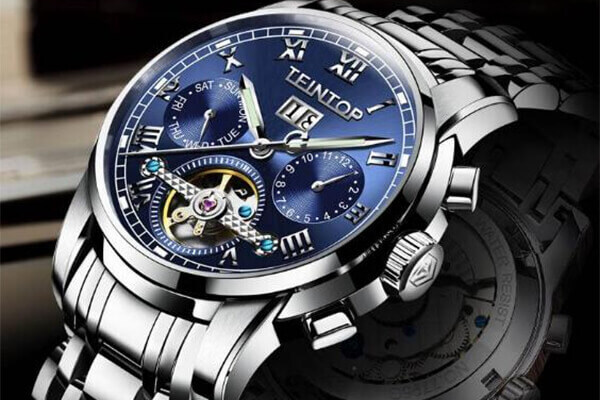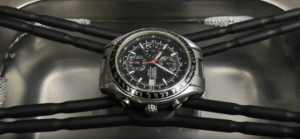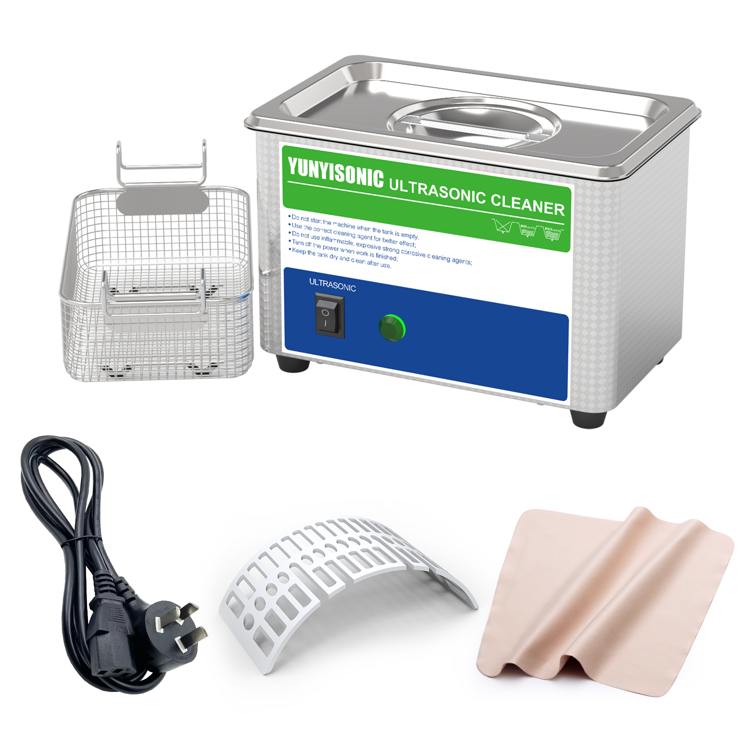There is something intimate about a watch. Whether it is a vintage heirloom passed down through generations or a sleek modern piece worn daily, a watch is more than a tool—it is a companion, a statement, even a legacy. But over time, even the most meticulously worn timepieces can fall victim to life’s daily dust, grime, and invisible residue. When a microfiber cloth or a toothbrush no longer does the job, many owners begin to explore more advanced cleaning methods. And somewhere along the line, they encounter the ultrasonic cleaner.
It sounds almost too good to be true. A small machine that uses sound waves to lift away stubborn dirt from the most delicate and intricate surfaces—no scrubbing, no scratches. But then comes the inevitable question: Can I clean my watch in an ultrasonic cleaner? The answer, as with most things mechanical and beautiful, lies in nuance.
How Ultrasonic Cleaning Works and Why It’s Different from Regular Cleaning
At first glance, ultrasonic cleaning feels almost like magic. No vigorous brushing, no harsh chemicals, and yet it manages to reach the tiniest spaces—between links, under bezels, around crowns—places even the most attentive hand cannot easily access. The science behind it, however, is firmly grounded in physics.

The Principle Behind Ultrasonic Cleaning
Ultrasonic cleaners generate high-frequency sound waves, typically between 20 to 120 khz through a transducer bonded to the bottom of a liquid-filled tank. These sound waves create microscopic bubbles in the cleaning solution in a process known as cavitation. As these bubbles collapse, they release tiny bursts of energy that dislodge dirt, oil, and other contaminants from the surfaces of objects immersed in the tank.
Now, why is this particularly relevant to watches? Watches—especially those with metal bracelets, detailed lugs, or ornamental engravings—are a maze of hard-to-reach zones. Grime often accumulates in the crevices where the strap meets the case or in the tiny grooves of a clasp. The collapsing microbubbles of ultrasonic cleaning fluid penetrate these hidden pockets with surprising precision, providing a level of cleanliness that brushing and polishing simply cannot match.
However, this process is powerful, and therein lies the concern. While the vibration and energy release are measured and usually gentle enough for many materials, they can be too harsh for certain components of a watch, particularly if the watch is submerged in its entirety. Which brings us to the next logical question: Should the entire watch go into the ultrasonic bath?
What Parts of a Watch Are Safe for Ultrasonic Cleaning?
While the allure of restoring your watch to showroom sparkle is tempting, ultrasonic cleaning is not a one-size-fits-all solution. Watches are delicate ecosystems, often blending metal, lubricated gears, electronic modules, synthetic seals, and even adhesives—all within a few millimeters of space. Understanding which parts can safely withstand ultrasonic energy is crucial to preserving both the beauty and function of your timepiece.
Generally speaking, metal watch bands—especially those made from stainless steel or titanium—are perfect candidates for ultrasonic cleaning. These components are solid, non-porous, and resilient, making them ideal for withstanding the cavitation process. You’ll often see professional jewelers place just the band, detached from the case, into a cleaning basket. After a few minutes, years of accumulated grime, skin oils, and tiny grit particles vanish, leaving behind a clean, polished finish.
On the other hand, the watch case, especially if it contains a movement, battery, or mechanical components, should not be placed into an ultrasonic cleaner unless the watch is explicitly labeled as safe for full immersion—and even then, with caution. Even watches rated as water-resistant are not necessarily ultrasonic-resistant. The intense vibrations from ultrasonic waves can:
- Compromise rubber gaskets or seals
- Dislodge or damage tiny internal components
- Allow moisture to seep into the case
- Loosen or fog protective coatings on sapphire or mineral glass
If your watch features leather bands, vintage adhesives, mother-of-pearl inlays, or stones embedded in bezels, ultrasonic cleaning should be avoided entirely. Natural materials tend to absorb water or become discolored under intense vibration. Adhesives may soften or break down, especially in older or handmade watches.
Some modern smartwatches and high-end pieces now come with sealed cases and specific manufacturer guidelines for ultrasonic cleaning, but unless those instructions explicitly state full compatibility, it’s safer to detach and clean only the metal band.

watch
How to Clean a Watch Band in an Ultrasonic Cleaner
Before you reach for your ultrasonic machine, there are a few key steps to consider—because successful cleaning is as much about the preparation as it is about the technology itself.
Step 1: Detach the Watch Band (If Possible)
The safest approach is to remove the band from the watch case. If you’re dealing with a metal bracelet and you’re unsure how to detach it, consider visiting a jeweler or using a spring bar tool with care. Separating the band eliminates any risk of moisture or vibration damage to the watch’s movement or seals.
Step 2: Choose the Right Cleaning Solution
While water alone can work to some degree, it is much more effective to use a diluted ultrasonic cleaning solution. For metal watch bands, a mild alkaline detergent or even a few drops of dish soap in warm distilled water works well. Make sure the solution is non-corrosive and free of ammonia or strong solvents, especially if your band has gold plating or brushed finishes.
Step 3: Place the Band in the Basket
Never drop the band directly into the tank. Instead, place it in the provided mesh basket or a dedicated watch holder. This avoids direct contact with the tank floor, which can interfere with ultrasonic vibrations and damage the transducers over time. Arrange the band in a slightly open position if possible so that the solution can reach the inner links.
Step 4: Set the Time and Temperature
A typical cleaning session should last between 2 to 5 minutes. For temperature, around 40°C (104°F) is optimal for loosening grime without damaging finishes. Some watch bands that are extremely dirty may benefit from a second cycle, but always inspect after the first round.
Step 5: Rinse and Dry Thoroughly
After the cycle finishes, lift the basket and rinse the band under clean, warm water to wash away any loosened debris or detergent residue. Use a soft brush, like a toothbrush, to gently scrub between the links if needed. Then, dry it thoroughly with a microfiber cloth or lint-free towel. Compressed air can help push water out of tight crevices. Let it sit out for at least 30 minutes before reattaching to the watch case.
Comparing Ultrasonic Cleaning with Other Watch-Cleaning Methods
When choosing how to clean your watch, it often comes down to convenience, safety, and thoroughness. Here’s how ultrasonic cleaning compares to alternatives like manual brushing, professional cleaning, and simple cloth wiping.
Manual Cleaning (Soap and Toothbrush)
The tried-and-true method of warm soapy water and a soft toothbrush is still widely used. It’s safe, low-cost, and allows for tactile control. However, it has limitations. Dirt inside links or beneath pins is often hard to reach, and excessive scrubbing may damage delicate surfaces or coatings. It’s also time-consuming, especially for watches with complex designs or engravings.
Ultrasonic Cleaning at Home
This method shines for its convenience and depth of cleaning. In just a few minutes, ultrasonic waves penetrate deep into hard-to-reach spaces. No physical force is needed, which reduces wear. However, it requires caution: you must remove delicate parts, avoid harsh solutions, and monitor cleaning times. For those who wear their watches daily, it’s a game-changer—keeping the band looking like new without constant effort.
Professional Watch Cleaning Services
Jewelers and watchmakers often use commercial ultrasonic cleaners paired with expert inspection and lubrication. They can fully disassemble your watch, clean each component safely, and reassemble it to factory condition. This is ideal for expensive or vintage watches. The tradeoff, of course, is time and cost—expect to wait days and pay a premium.
Simple Cloth Wiping or Spray Cleaners
These are good for maintenance in between deep cleans. A microfiber cloth removes fingerprints and dust with zero risk, and lens-safe sprays can help with grease buildup. But again, they only clean the surface and do not address hidden dirt.
| Cleaning Method | Depth of Cleaning | Risk Level | Recommended For | Frequency |
|---|---|---|---|---|
| Ultrasonic Cleaner | High | Moderate (if misused) | Metal bands, daily wearers | Weekly to bi-weekly |
| Manual Brushing | Moderate | Low | Any type, esp. vintage | Weekly |
| Professional Cleaning | Very High | Very Low | Luxury or vintage watches | Every 6-12 months |
| Cloth Wiping | Low | None | Daily spot cleaning | Daily |
Common Mistakes to Avoid When Cleaning Watches with Ultrasonic Cleaners
Even though ultrasonic cleaners are highly effective, they are not foolproof. When used improperly, they can do more harm than good—especially with watches that have delicate finishes or intricate construction. Understanding what not to do is just as important as knowing how to do it right.
One of the most common mistakes is placing the entire watch—including the head or case—into the ultrasonic tank. Unless your watch is fully waterproof and specifically designed to withstand pressure and vibration, this is risky. Moisture can seep past seals and gaskets, potentially fogging the dial, corroding internal components, or even ruining a quartz movement.
Another frequent error is using the wrong cleaning solution. Harsh chemicals like ammonia-based cleaners, alcohol, or industrial degreasers may react poorly with metal plating, damage coatings, or cloud crystals. It’s also unwise to use very hot water, as it may deform plastic parts or disturb glue-bound joints. The safest approach is to use lukewarm distilled water with a drop or two of mild, pH-neutral detergent.
Users sometimes assume longer cleaning times equal better results. But more is not always better. Prolonged exposure to ultrasonic waves may wear down softer metals or cause fine scratches, particularly on plated surfaces like gold-tone bracelets. A cycle of 3 to 5 minutes is generally sufficient for most bands, and repeating a cycle is safer than running one excessively long session.
Failing to suspend the watch band properly is another issue. Laying metal parts directly on the tank floor can block ultrasonic wave circulation and potentially damage the cleaner’s transducers. Always use the cleaning basket, mesh tray, or a suspension hook to keep your items elevated and stable during the cleaning process.
It’s also important to rinse thoroughly after cleaning. Even a gentle detergent can leave residues if not fully washed away, leading to dullness or discomfort when worn. Follow up with a rinse in clean distilled water and gently pat dry using a microfiber cloth.
Lastly, skipping inspection before cleaning is risky. Older watches with loose links, worn-out spring bars, or damaged clasps may suffer further harm if not addressed beforehand. If you spot corrosion, rattling sounds, or loose parts, it’s wise to seek professional evaluation first.
Which Watches Are Safe to Clean with Ultrasonic Cleaners?
Not all watches are created equal—especially when it comes to ultrasonic cleaning. Whether or not a watch is suitable for this method depends on multiple factors, including its construction, materials, age, and water resistance rating. Understanding these variables can help you decide what’s safe to submerge and what’s better left to manual cleaning.
Stainless steel watch bands without attached heads are among the safest items to clean ultrasonically. These are durable, resistant to mild cleaning agents, and designed to withstand the mild vibration and cavitation of ultrasonic baths. Bracelets made from solid links, especially those without glued elements, usually fare well during ultrasonic cleaning and emerge significantly brighter and smoother.
However, even stainless steel needs to be approached with care. If the band features gold plating, PVD coatings, or decorative inlays, the ultrasonic process might wear these finishes away over time—especially if combined with strong chemicals or long cleaning cycles. Always err on the side of caution with plated metals.
As for the watch heads, cleaning them in an ultrasonic bath is only recommended under very specific conditions. For example, high-end dive watches with a verified depth rating above 200 meters and recent pressure testing might be safe for brief ultrasonic cleaning. However, this is still not widely recommended unless you’re a professional watch technician using specialized equipment.
Vintage watches and mechanical timepieces are particularly vulnerable. Their seals may have deteriorated, or the materials might be too delicate to withstand the stress. In some cases, the crystal (especially if it’s acrylic or mineral glass) can develop microfractures or loosen from its housing. Similarly, watches with decorative stones, enamel dials, or luminous paint should never go in an ultrasonic bath.
Watches that incorporate adhesives, such as for mounting bezels or holding decorative elements, are also at risk. Ultrasonic cavitation can weaken or dissolve these glues, leading to permanent damage.
Smartwatches and fitness trackers, while often waterproof, are also a bad fit for ultrasonic cleaning. Their internal electronics are not designed to handle vibration-based cleaning, and any tiny crack or manufacturing defect could allow water ingress.
For those unsure about whether their watch qualifies, the best approach is this: remove the strap and clean it separately. If your strap is made of stainless steel, metal mesh, or rubber, it can likely be cleaned with an ultrasonic cleaner safely. Leave the watch head out of the tank, and give it a gentle manual clean with a microfiber cloth and a damp cotton swab.
With a little extra care and a cautious eye, ultrasonic cleaning becomes not only a powerful tool for keeping your timepieces beautiful—it becomes part of a long-term preservation strategy for something as personal and treasured as a watch.
How to Use an Ultrasonic Cleaner for Watch Bands Safely
Once you’ve confirmed that your watch strap is suitable for ultrasonic cleaning, the actual process is fairly straightforward—but there are still some important best practices to follow. The goal is not just to clean effectively, but also to extend the life of both the watch component and the ultrasonic machine itself.
Begin by preparing the ultrasonic tank. Use warm, not hot, distilled water and add a few drops of a mild, non-corrosive cleaning agent. Many experts recommend a pH-neutral or mildly alkaline solution that is safe for metals and coatings. Avoid harsh industrial solvents, bleach, or anything that foams excessively, as these can either damage the surface or interfere with cavitation.
Place the watch band into the basket or suspension tray that comes with the cleaner. This part is crucial: placing the metal directly on the bottom of the tank risks damaging both the cleaner and the item. The basket helps ensure that ultrasonic waves distribute evenly, promoting thorough and balanced cavitation.
Cycle time depends on the condition of the band. For routine maintenance, a 2–5 minute session is usually enough. For extremely dirty or oily bands, you might extend the session slightly, but always monitor the process. Once finished, rinse the band thoroughly with clean distilled water and dry it with a soft, lint-free cloth.

A luxury wristwatch with a metal band mounted on a stand inside an ultrasonic cleaner
Never forget to inspect the band afterward, especially at hinge points or under clasp mechanisms, where residue might accumulate. A soft toothbrush can be used post-cleaning to dislodge any stubborn particles without scratching the surface.
Store your cleaned bands properly—away from excessive humidity or direct sunlight. For leather or fabric straps, ultrasonic cleaning is not appropriate at all. These materials absorb water and cleaning agents, which can degrade them over time or cause distortion.
Even though ultrasonic cleaners offer an impressive level of cleanliness, they should not be used excessively. Overuse, especially on plated or coated metals, can result in gradual wear. Treat ultrasonic cleaning as a periodic refresh—not a daily habit—and your bands will reward you with a long-lasting shine.
A Watchful Decision: Balancing Effectiveness and Caution
Using an ultrasonic cleaner for watches comes down to knowing your watch, your cleaner, and the science behind how the two interact. While the temptation to pop your entire timepiece into the machine is understandable, a moment of pause can save you from irreparable harm. From luxury mechanical watches with intricate inner gears to affordable quartz models with glued crystals, the level of risk varies. That’s why professionals often recommend cleaning only the detachable parts like metal straps unless you’re equipped with the knowledge—and the confidence—to go deeper.
In the world of horology, maintenance is part of the love. Whether you wear a rugged diver’s watch or a minimalist dress timepiece, proper cleaning preserves more than aesthetics—it honors craftsmanship. If ultrasonic cleaning feels like a mystery, remember that it’s simply a tool. And like any tool, it works best when used mindfully, backed by understanding rather than assumptions.
Watchmakers, jewelers, and ultrasonic equipment manufacturers all echo a similar sentiment: ultrasonic cleaning is powerful and transformative, but it’s not universal. Use it where it shines—in grime-laden watch bracelets, encrusted links, and metal cases that can handle the ride. But leave the delicate internals to the experts, and the leather to gentler methods.
Let your cleaning routine reflect the same care you show when choosing your watch each day. When in doubt, clean less but clean smart. That way, your timepiece will not only look the part—it’ll stand the test of time.


